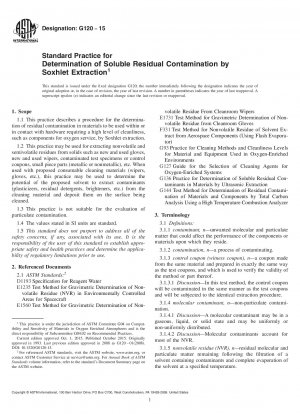ASTM G120-15
Standard Practice for Determination of Soluble Residual Contamination by Soxhlet Extraction
- Standard No.
- ASTM G120-15
- Release Date
- 2015
- Published By
- American Society for Testing and Materials (ASTM)
- Status
- Replace By
- ASTM G120-15(2023)
- Latest
- ASTM G120-15(2023)
- Scope
5.1 It is expected that this practice will be suitable to identify and quantify contaminants found in systems, system materials, and components used in systems requiring a high level of cleanliness, such as components for oxygen service. Nonmetallic piece parts such as seals and valve seats can be tested as received. Warning—If parts being tested are to be subsequently installed in an oxygen-enriched system, residual extraction solvent remaining in the part due to inadequate drying may increase the susceptibility of the system to ignition. The extraction solvent shall be thoroughly removed from the parts prior to service.
5.2 Processing materials such as gloves and wipers, or samples thereof, to be used in the cleaning operation can be evaluated prior to use to ensure that the proposed cleaning solvent does not extract contaminants that may be deposited as residues on the surface to be cleaned.
Note 1: Test methods that do not require Soxhlet equipment, such as Test Methods E1560 and E1731, may be suitable alternatives for evaluation of processing materials. Test Method G144 with Practice G136 may be suitable for use when the material to be tested is not degraded by sonication. However, results from this test method cannot be directly compared to results from other test methods. Soxhlet extraction may be more aggressive than other extraction methods.
5.3 Wipers or other cleaning supplies can be tested before and after use to determine the amount of contaminant removed from a surface. The type of contaminant removed from the surface may also be determined by qualitative analysis of the extracted NVR using analytical methods such as Fourier Transform Infrared (FTIR). This procedure can be used to obtain samples for NVR analysis using contaminated control coupons that were subjected to the cleaning process as controls to validate cleaning operations.
5.4 The selection of the solvent requires some knowledge of the contaminant (see Practice G93 for recommendations). If a nonvolatile residue (NVR) analysis is to be performed on the molecular contaminant, the boiling point of the solvent shall be significantly lower than that of the contaminant. For other analytical methods, the tester must know the accuracy of the analytical methods, and the solvent shall be chosen so as not to interfere with the selected analytical method. To identify the composition of the NVR, analytical methods such as infrared spectroscopy or gas chromatography/mass spectroscopy have been used satisfactorily.
1.1 This practice describes a procedure for the determination of residual contamination in materials to be used within or in contact with hardware requiring a high level of cleanliness, such as components for oxygen service, by Soxhlet extraction.
1.2 This practice may be used for extracting nonvolatile and semivolatile residues from solids such as new and used gloves, new and used wipers, contaminated test specimens or c......
ASTM G120-15 Referenced Document
- ASTM D1193 Standard Specification for Reagent Water
- ASTM E1235 Standard Test Method for Gravimetric Determination of Nonvolatile Residue (NVR) in Environmentally Controlled Areas for Spacecraft
- ASTM E1560 Standard Test Method for Gravimetric Determination of Nonvolatile Residue From Cleanroom Wipers
- ASTM E1731 Standard Test Method for Gravimetric Determination of Nonvolatile Residue from Cleanroom Gloves
- ASTM F331 Standard Test Method for Nonvolatile Residue of Solvent Extract from Aerospace Components (Using Flash Evaporator)
- ASTM G127 Standard Guide for the Selection of Cleaning Agents for Oxygen Systems
- ASTM G136 Standard Practice for Determination of Soluble Residual Contaminants in Materials by Ultrasonic Extraction
- ASTM G144 Standard Test Method for Determination of Residual Contamination of Materials and Components by Total Carbon Analysis Using a High-Temperature Combustion Analyzer
- ASTM G93 Standard Practice for Cleaning Methods and Cleanliness Levels for Material and Equipment Used in Oxygen-Enriched Environments
ASTM G120-15 history
- 2023 ASTM G120-15(2023) Standard Practice for Determination of Soluble Residual Contamination by Soxhlet Extraction
- 2015 ASTM G120-15 Standard Practice for Determination of Soluble Residual Contamination by Soxhlet Extraction
- 2001 ASTM G120-01(2008) Standard Practice for Determination of Soluble Residual Contamination in by Soxhlet Extraction
- 2001 ASTM G120-01 Standard Practice for Determination of Soluble Residual Contamination in by Soxhlet Extraction
- 1995 ASTM G120-95(2001) Standard Practice for Determination of Soluble Residual Contamination in by Soxhlet Extraction
- 1995 ASTM G120-95 Standard Practice for Determination of Soluble Residual Contamination in by Soxhlet Extraction

Copyright ©2024 All Rights Reserved